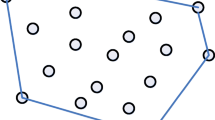Abstract
This paper describes an algorithm for computing three-dimensional convex hulls. First, we introduce a simple algorithm to compute two-dimensional convex hulls using graphics hardware. This algorithm computes the edges and the facets of the convex hulls by analyzing bitmap images drawn using given points. Graphics hardware can generate bitmap images of three-dimensional objects very rapidly. We then expand the algorithm to compute three-dimensional convex hulls. Finally, we apply the algorithm to compute Delaunay diagrams. The algorithm is very simple. Hoff et al. reported an algorithm to draw Voronoi diagrams using graphics hardware [3]. Our algorithms are based on the same technique used by [3]. However, our algorithm employs an analyzing phase of the images and obtains topological information from the image.
The diagrams produced by our algorithm are not strict Delaunay diagrams, because the images we obtain using graphics hardware are bitmap images and are not continuous. Therefore, they may contain some errors but, because of the simplicity of the algorithm, they are stable compared with ordinary algorithms, without a requirement for special techniques, such as symbolic perturbation. The algorithms can be easily implemented.
Similar content being viewed by others
References
H. Edelsbrunner and E. Mucke, Simulation of simplicity — a technique to cope with degenerate cases in geometric algorithms. Proceedings of the 4th ACM Annual Symposium on Computational Geometry, Urbana-Champaign, Illinois, ACM, 1988, 118–133.
S. Fortune, A sweepline algorithm for Voronoi diagrams. Algorithmica,2 (1987), 153–174.
K.E. Hoff, T. Culver, J. Keyser, M. Lin and D. Manocha, Fast computation of generalized Voronoi diagrams using graphics hardware. Proceedings of ACM SIGGRAPH Annual Conference on Computer Graphics, Los Angeles, California, ACM, 1999, 277–286.
M.J. Kilgard, OpenGL Programming for the X Window System. Addison-Wesley, 1996.
T. Ohya, M. Iri and K. Murota, Improvement of incremental method for Voronoi diagram with computational comparison of algorithms. Journal of Operations Research Society of Japan,27 (1985), 306–336.
A. Okabe, B. Boots and K. Sugihara, Spatial Tessellations — Concepts and Applications of Voronoi Diagrams. John-Wiley, 1992.
M.I. Shamos and D. Hoey, Closest-point problems. Proceedings of Annual IEEE Symposium on Foundation of Computer Science, IEEE, 1975, 151–162.
M. Woo, J. Neider, T. Davis and D. Shreiner, OpenGL Programming Guide (third edition ed.). Addison Wesley, 1999.
O. Yamamoto, Fast display of Voronoi diagrams over planes and spheres using graphics hardware. Transactions of the Japan Society for Industrial and Applied Mathematics,12, No. 3 (2002), 209–234 (in Japanese).
C.-K. Yap, A geometric consistency theorem for a symbolic perturbation scheme. Proceedings of 4th ACM Annual Symposium on Computational Geometry, Urbana-Champaign, Illinois, ACM, 1988, 134–142.
Author information
Authors and Affiliations
About this article
Cite this article
Yamamoto, O. Fast computation of three-dimensional convex hulls using graphics hardware. Japan J. Indust. Appl. Math. 22, 291–310 (2005). https://doi.org/10.1007/BF03167444
Received:
Revised:
Issue Date:
DOI: https://doi.org/10.1007/BF03167444




